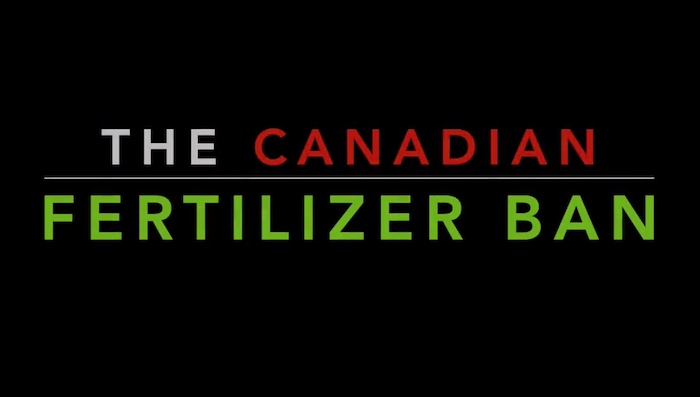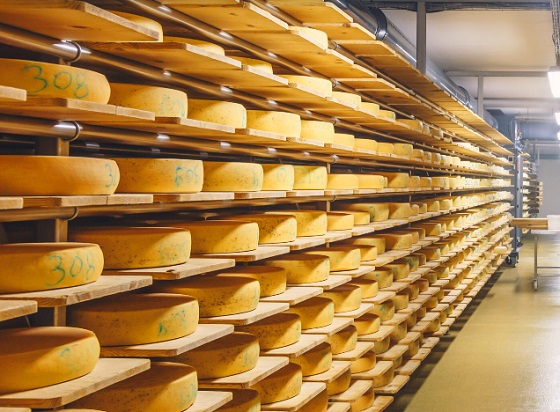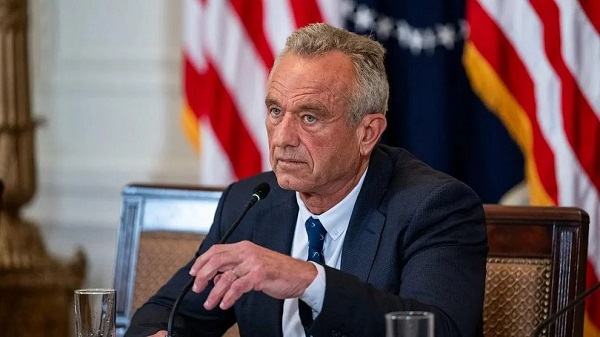Agriculture
Global food shortage? So what! Governments want to reduce the use of fertilizer anyway

Once we acknowledge that over 80% of Canadians live in cities (and an even larger percentage seemingly don’t care much about poor people) it’s much easier to understand why the average Canadian isn’t far more upset with the government’s plan to coerce farmers to cut back on nitrogen fertilizer (otherwise known as plant food).
As complex as the formulas are for estimating the amount of pollution caused by fertilizer use, there’s actually a very simple way to understand this initiative. So let’s simplify. In order to help reduce Canada’s share (about 1%) of global emissions (which a ton of scientists swear is making the world hotter.. Sorry not hotter.. but more climate changy…which actually somehow means worse for everyone everywhere) the government is strongly urging farmers to use less fertilizer and thereby produce less food. The federal government estimates farming is responsible for about 10% of Canada’s emissions. Now that’s all aspects of farming including everything from using nitrogen fertilizer, to driving tractors, to presumably the horrible practice farmers share of breathing out every couple of seconds (more when they’re working hard). They estimate nitrogen fertilizer is responsible for about 18% of the emissions from farming (see below). In other words, this has to stop! I mean 18% of 10% of 1%.. how did we let this get so far away on us?
But here’s a question. Why would a farmer (who is a business operator) want to produce less food (which is the product farmers make and sell to feed the world)? Until now, farmers have always taken pride in producing the best possible crops using the lowest possible inputs (all the expenses from gas to seed to fertilizer, etc). Who wouldn’t? It’s how they make their money. Sounds like a tough sell. Perhaps that’s why governments are coming out with programs that will pay farmers not to farm quite so much. Right here in Alberta there’s a program that could pay an individual farmer up to $75,000.00 to cut back and be a better producer (government talk for producing less food) for people (not poor people who may starve in the coming months) fortunate enough to live 100 years from now.
Sure. That may sound a little offside when you consider global food shortages (another term for starving people) are expected to increase drastically in the coming months. You see the world is always somewhere between a little short of food and desperately short of food (depending on where you live you might feel more ‘desperate’ than inconvenienced). A simple minded person like myself might say “Why would we mess with this system that is feeding more people successfully than at any other time in world history?” Silly me. These guys are way beyond that simple thinking. That’s why the government isn’t asking farmers to consider what’s happening in the world right now (8 billion people need to eat). The government is asking farmers to consider what ‘might’ happen sometime in the future (it may sound a bit wacky when we say it out loud, but we’re pretty sure we can stop the climate from changing).
Apparently in order to get the climate under our control, we should be OK if we have to sacrifice a few million (or multiple hundred million) eaters (another word for people) in the next few years (could be starting in the next few months).
Relax Canadians. We can continue to fly across the country to go surfing in honour of the National Day for Truth and Reconciliation (I saw you there on the beach didn’t I?). We’re almost surely not going to miss a meal. Yah, we might have to double or triple down at the grocery store, but just think of that perfect summer day in the future! You’ll be so happy when your child gleefully watches your grandchild in their paper swim suit splash away in the wooden baby pool that’s in the driveway where the car used to be out front of the rental (now that we won’t be allowed to own cars anymore there’s going to be so much more room in our driveways!) Too bad you can’t travel to be there in person because you’re still getting that ESG score back up after that trip to see the kids a couple years back. Too bad you can’t use that cool social media app to see what they posted because you accidentally typed Turdo instead of Trudeau six months ago (stupid spellcheck).
Here’s to a bright future without the constant worry of oil and gas and nitrogen fertilizer! Just think. No more storms. No more pesky record high or low temperatures. And water levels remain constant year in and year out. It’s going to be awesome (for all the descendants of the people who get to eat in the next couple of years). Maybe we’ll build a statue to honour today’s fearless leaders who are so smart they have realized that it’s NOT THEIR JOB TO PROTECT THE PEOPLE WHO VOTE FOR THEM TODAY, but to CREATE A BETTER FUTURE FOR THE DESCENDANTS OF THOSE WHO CAN AFFORD TO SURVIVE in the future! We’ll certainly inscribe it with something like “These guys weren’t afraid to crack a few eggs to make this omelette. Hope you enjoy omelettes!” I think the perfect location to put that statue will be Davos. I hear it’s beautiful. Speaking of omelettes I hope there are still chickens in the future. I understand those little runts like farting as much as cows do and don’t kid yourself, it adds up!
I digress. This isn’t all about my wandering thoughts. As a journalistic endeavour I’d like to present both sides of thinking on this initiative. This should help teach those simple farmers and their university educated consultants how to farm better with less fertilizer and more crop rotation, etc. (I’m still amazed farmers didn’t already figure this out for themselves, but I bow to those worldly thinkers who make these plans on “our” behalf.) Anyway, a few thoughts from Agriculture Canada, followed by an informative (and entertaining) video presentation from a very well known Saskatchewan farmer.
—–
These statements have been pulled from the “Discussion Document: Reducing emissions arising from the application of fertilizer in Canada’s agriculture sector” on the federal government’s website. You can read it all here but I’ve pulled a couple of statements to help explain the brilliant future forward thinking that goes into plans like this. So please read about why our governments are telling farmers to grow less food to feed fewer people at a time of food shortages.
” In December 2020, the Government of Canada announced its Strengthened Climate Plan, “A Healthy Environment and a Healthy Economy.” It includes a number of measures affecting the agriculture sector, with a goal to reduce greenhouse gas (GHG) emissions, and increase carbon sequestration. This discussion paper addresses one of these measures: a national target to reduce absolute levels of GHG emissions arising from fertilizer application by 30% below 2020 levels by 2030.
Background
Agriculture was responsible for approximately 10% of Canada’s GHG emissions in 2019, or 73 Mt CO2, which come from three main sources: enteric fermentation (24Mt), crop production (24Mt) , and on-farm fuel use (14Mt) (National Inventory Report, 2021.) Based on current data for 2019, emissions from synthetic fertilizers accounted for 12.75 Mt. While many players in the agriculture sector are already working to improve nutrient management and reduce emissions associated with crop production, fertilizers are responsible for a growing share of overall agricultural emissions.
Since the release of Canada’s Strengthened Climate Plan, the Government of Canada has moved swiftly to implement its key aspects in order to create jobs, grow the economy and protect the planet. In April 2021, in line with its obligations under the Paris Agreement, the Government of Canada announced a new GHG emissions reduction target of 40-45% below 2005 levels by 2030. This target, along with other developments such as the passage of the Canadian Net Zero Emissions Accountability Act, which enshrines in legislation Canada’s commitment to achieve net-zero emissions across the Canadian economy by 2050, highlights the need to reduce absolute GHG emissions across all economic sectors, including agriculture.
—–
This part is really interesting because it shows how fertilizer use is far more intense in Quebec and the Maritime provinces, though the bulk of the reductions will have to take place in Western Canada anyway. You know, because.. even though western farmers use less, there are more of them so they actually use more, plus they’re farther away from Ottawa and have less representation per capita.. what was I saying?
Regional Variations
Fertilizer induced emissions are not spatially or temporally uniform across Canadian agricultural landscapes. The seasonal pattern of N2O emissions reflects the interaction between soil temperature, soil water and nitrate availability. Drier regions of the Prairies have much lower N2O losses than the moister regions of Eastern Canada. N2O emissions per hectare are greater in Eastern Canada as a result of the wetter climate and greater N application rates. However, the much larger land area in the Prairies vs. Eastern Canada results in greater total N fertilizer application in the Prairies and thus the total emissions are much higher in this region.
It is important to note that the strategies required to achieve the 30% N2O emission reduction objective will vary across the country as the emissions reduction potential is impacted by biophysical factors (soil type, soil humidity, climate), crop types, and climate change impacts.Footnote3 (OH DEAR GOD CLIMATE CHANGE IS CAUSING MORE CLIMATE CHANGE!)
Figure 3 illustrates the differences between the fertilizer induced emissions patterns across the country, showing N2O emissions per hectare in 2018. The intensity of fertilizer emissions (emissions per ha) is higher east of Saskatchewan, indicating that more fertilizer is applied per hectare, resulting in more direct emissions on a per-acre basis. In addition, wetter conditions in the East result in more direct and indirect emissions.

—–
This part clearly explains how regions that use less fertilizer may be asked to cut back even more than regions using a lot more per capita, because.. because. Also it encourages farmers to stop the nasty habit of pouring fertilizer out randomly all over the place and then grabing a pinch and throwing it over their shoulder. For some reason it still hasn’t addressed when farmers (and their family members) exhale, which is also more intense in heavily populated urban areas in the east (likely because it’s not N2O, but CO2).
Objectives of the National Target for Fertilizer Emissions
In order to achieve a concrete reduction in overall emissions, the target is established relative to absolute emissions rather than emissions intensity. The Government of Canada has been clear that the objective of the national target for fertilizers is to reduce emissions, and that the primary method to achieve this is not to establish a mandatory reduction in fertilizer use that isn’t linked to improved efficiency and maintaining or improving yields. Rather, the goal is to maximize efficiency, optimize fertilizer use, encourage innovation, and to work collaboratively with the agriculture sector, partners and stakeholders in identifying opportunities that will allow us to successfully reach this target.
—–
OK. I don’t expect you were able to understand most of that. But they did their best to explain to those of us who aren’t as good as planning future world scenarios as they are. Now that you see the way our fearless leaders think. But what about the rest of us? In the interest of journalistic integrity we’ll show you what one simple farmer thinks of being urged to use less fertilizer. If you haven’t seen QDM before, please note he sometimes uses very descriptive adjectives (sometimes he turns them into verbs and nouns too) which might be a tad harsh for the younger folk. Please enjoy with a grain of salt and a malted beverage. When he’s finished you can decide for yourself whether you think it’s a great idea to cut back on food production by using less fertilizer.
Agriculture
End Supply Management—For the Sake of Canadian Consumers

This is a special preview article from the:
U.S. President Donald Trump’s trade policy is often chaotic and punitive. But on one point, he is right: Canada’s agricultural supply management system has to go. Not because it is unfair to the United States, though it clearly is, but because it punishes Canadians. Supply management is a government-enforced price-fixing scheme that limits consumer choice, inflates grocery bills, wastes food, and shields a small, politically powerful group of producers from competition—at the direct expense of millions of households.
And yet Ottawa continues to support this socialist shakedown. Last week, Prime Minister Mark Carney told reporters supply management was “not on the table” in negotiations for a renewed United States-Mexico-Canada Trade Agreement, despite U.S. negotiators citing it as a roadblock to a new deal.
Supply management relies on a web of production quotas, fixed farmgate prices, strict import limits, and punitive tariffs that can approach 300 percent. Bureaucrats decide how much milk, chicken, eggs, and poultry Canadians farmers produce and which farmers can produce how much. When officials misjudge demand—as they recently did with chicken and eggs—farmers are legally barred from responding. The result is predictable: shortages, soaring prices, and frustrated consumers staring at emptier shelves and higher bills.
This is not a theoretical problem. Canada’s most recent chicken production cycle, ending in May 2025, produced one of the worst supply shortfalls in decades. Demand rose unexpectedly, but quotas froze supply in place. Canadian farmers could not increase production. Instead, consumers paid more for scarce domestic poultry while last-minute imports filled the gap at premium prices. Eggs followed a similar pattern, with shortages triggering a convoluted “allocation” system that opened the door to massive foreign imports rather than empowering Canadian farmers to respond.
Over a century of global experience has shown that central economic planning fails. Governments are simply not good at “matching” supply with demand. There is no reason to believe Ottawa’s attempts to manage a handful of food categories should fare any better. And yet supply management persists, even as its costs mount.
Those costs fall squarely on consumers. According to a Fraser Institute estimate, supply management adds roughly $375 a year to the average Canadian household’s grocery bill. Because lower-income families spend a much higher proportion of their income on food, the burden falls most heavily on them.
The system also strangles consumer choice. European countries produce thousands of varieties of high-quality cheeses at prices far below what Canadians pay for largely industrial domestic products. But our import quotas are tiny, and anything above them is hit with tariffs exceeding 245 percent. As a result, imported cheeses can cost $60 per kilogram or more in Canadian grocery stores. In Switzerland, one of the world’s most eye-poppingly expensive countries, where a thimble-sized coffee will set you back $9, premium cheeses are barely half the price you’ll find at Loblaw or Safeway.
Canada’s supply-managed farmers defend their monopoly by insisting it provides a “fair return” for famers, guarantees Canadians have access to “homegrown food” and assures the “right amount of food is produced to meet Canadian needs.” Is there a shred of evidence Canadians are being denied the “right amount” of bread, tuna, asparagus or applesauce? Of course not; the market readily supplies all these and many thousands of other non-supply-managed foods.
Like all price-fixing systems, Canada’s supply management provides only the illusion of stability and security. We’ve seen above what happens when production falls short. But perversely, if a farmer manages to get more milk out of his cows than his quota, there’s no reward: the excess must be
dumped. Last year alone, enough milk was discarded to feed 4.2 million people.
Over time, supply management has become less about farming and more about quota ownership. Artificial scarcity has turned quotas into highly valuable assets, locking out young farmers and rewarding incumbents.
Why does such a dysfunctional system persist? The answer is politics. Supply management is of outsized importance in Quebec, where producers hold a disproportionate share of quotas and are numerous enough to swing election results in key ridings. Federal parties of all stripes have learned the cost of crossing this lobby. That political cowardice now collides with reality. The USMCA is heading toward mandatory renegotiation, and supply management is squarely in Washington’s sights. Canada depends on tariff-free access to the U.S. market for hundreds of billions of dollars in exports. Trading away a deeply-flawed system to secure that access would make economic sense.
Instead, Ottawa has doubled down. Not just with Carney’s remarks last week but with Bill C-202, which makes it illegal for Canadian ministers to reduce tariffs or expand quotas on supply-managed goods in future trade talks. Formally signalling that Canada’s negotiating position is hostage to a tiny domestic lobby group is reckless, and weakens Canada’s hand before talks even begin.
Food prices continue to rise faster than inflation. Forecasts suggest the average family will spend $1,000 more on groceries next year alone. Supply management is not the only cause, but it remains a major one. Ending it would lower prices, expand choice, reduce waste, and reward entrepreneurial farmers willing to compete.
If Donald Trump can succeed in forcing supply management onto the negotiating table, he will be doing Canadian consumers—and Canadian agriculture—a favour our own political class has long refused to deliver.
The original, full-length version of this article was recently published in C2C Journal. Gwyn Morgan is a retired business leader who was a director of five global corporations.
Agriculture
Supply Management Is Making Your Christmas Dinner More Expensive

From the Frontier Centre for Public Policy
By Conrad Eder
The food may be festive, but the price tag isn’t, and supply management is to blame
With Christmas around the corner, Canadians will be heading to the grocery store to pick up the essentials for a tasty Christmas feast. Milk and eggs to make dinner rolls, butter for creamy mashed potatoes, an assortment of cheeses as an appetizer, and, of course, the Christmas turkey.
All delicious. All essential. And all more expensive than they need to be because of a longstanding government policy. It’s called supply management.
Consider what a family might purchase when hosting Christmas dinner. Two cartons of eggs, two cartons of milk, a couple of blocks of cheese, a few sticks of butter, and an eight-kilogram turkey. According to Agriculture and Agri-Food Canada and Statistics Canada, that basket of goods costs a little less than $80.
Using price premiums calculated in a 2015 University of Manitoba study, Canada’s supply management system is responsible for $16.69 to $20.48 of the cost of that Christmas dinner. That’s a 21 to 26 per cent premium Canadian consumers pay on those five staples alone. Planning on making a yogurt dip or serving ice cream with dessert? Those extra costs continue to climb.
Canadians pay these premiums for poultry, dairy and eggs because of how Canada’s supply management system works. Farmers must obtain government-issued production quotas that dictate how much they’re allowed to produce. Prices are set by government bodies rather than in an open market. High tariffs block imports and restrict competition from international producers.
The costs of supply management are significant, amounting to billions of dollars every year, yet they are largely hidden, spread across millions of households’ grocery bills. Meanwhile, the benefits flow to a small number of quota-holding farmers. Their quotas are worth millions of dollars and help ensure profitable returns.
These farmers have every incentive to lobby, organize and defend the current system. Wanting special protection is one thing. Actually being given it is another. It is the responsibility of elected officials to resist such demands. Elected to represent all Canadians, politicians should unapologetically prioritize the public interest over any special interests.
Yet in June 2025, Parliament did the opposite. Rather than solve a problem that costs Canadians billions each year, members of Parliament from every party, Liberal, Conservative, Bloc, NDP and Green, unanimously approved Bill C-202, further entrenching the system that makes grocery bills more expensive at a time when families can least afford it. Bill C-202 prohibits Canada from offering any further market access concessions on supply-managed sectors in future trade negotiations.
This decision is even more disappointing when we consider what other nations have already accomplished. Australia and New Zealand demonstrate that removing supply management is not only possible but beneficial.
Australia operated a dairy quota system for decades before abolishing it in 2000. New Zealand began dismantling its dairy supply management regime in 1984 and completed the process in 2001. Both countries found that competitive markets provided their citizens with the access to goods they needed without the hidden costs. If these countries could eliminate supply management, so can Canada.
As the government scrambles to combat the rising cost of living, one of the simplest and most effective solutions continues to be ignored. Eliminating supply management. Removing the quotas, the price controls and the tariffs would allow market competition to do what it does across every other product category. It delivers choice, quality and affordability.
As Canadians gather for Christmas dinner, the feast may be delicious, but it will once again be more expensive than it needs to be. That is the cost of supply management, and Canadians should no longer have to bear it.
Conrad Eder is a policy analyst at the Frontier Centre for Public Policy.
-

 Uncategorized1 day ago
Uncategorized1 day agoMortgaging Canada’s energy future — the hidden costs of the Carney-Smith pipeline deal
-

 Business2 days ago
Business2 days agoThere’s No Bias at CBC News, You Say? Well, OK…
-

 International1 day ago
International1 day agoAustralian PM booed at Bondi vigil as crowd screams “shame!”
-

 Opinion2 days ago
Opinion2 days agoReligion on trial: what could happen if Canada passes its new hate speech legislation
-

 Automotive20 hours ago
Automotive20 hours agoCanada’s EV gamble is starting to backfire
-

 Agriculture17 hours ago
Agriculture17 hours agoEnd Supply Management—For the Sake of Canadian Consumers
-

 Alberta16 hours ago
Alberta16 hours agoAlberta Next Panel calls to reform how Canada works
-

 Environment14 hours ago
Environment14 hours agoCanada’s river water quality strong overall although some localized issues persist









